Subject to change without prior notice Revised 01-11
6 720 220 045
• Verify that the low voltage wiring between the
thermostat and the unit is correct
• Verify that the water piping is complete and
correct
• Check that the water ow is correct, and adjust if
necessary
• Check the blower for free rotation, and that it is
secured to the shaft
• Verify that vibration isolation has been provided
• Unit is serviceable. Be certain that all access
panels are secured in place
• Verify that the blower support has been removed
• Verify that duct work has been properly fastened
to supply and return duct collars
• Make sure return air lters are positioned
correctly in the lter rack if removed during
installation
UNIT START-UP
1. Set the thermostat to the highest setting.
2. Set the thermostat system switch to “COOL”,
and the fan switch to the “AUTO” position. The
reversing valve solenoid should energize. The
compressor and fan should not run.
3. Reduce the thermostat setting approximately 5
degrees below the room temperature.
4. Verify the heat pump is operating in the cooling
mode.
5. Turn the thermostat system switch to the “OFF”
position. The unit should stop running and the
reversing valve should de-energized
6. Leave the unit off for approximately (5) minutes
to allow for system equalization.
7. Turn the thermostat to the lowest setting. The
compressor and fan should not run.
8. Set the thermostat switch to “HEAT”.
9. Increase the thermostat setting approx-imately
5 degrees above the room temperature.
10. Verify the heat pump is operating in the
heating mode.
11. Set the thermostat to maintain the desired
space temperature.
14 CP/BP Series Unit Start up
12. Check for vibrations, leaks, etc...
13. Instruct the owner on the unit and thermostat
operation
MAINTENANCE
1. Filter changes or cleanings are required at
regular intervals. The time period between lter
changes will depend upon type of environment
the equipment is used in. In a single family
home, that is not under construction, changing
or cleaning the lter every 60 days may be
sufcient. In other applications such as motels,
where daily vacuuming produces a large
amount of lint, lter changes may be need to be
as frequent as biweekly. See unit specications
for replacement lter sizes. Note that horizontal
units containing two lters are taped together
at the factory to facilitate removal. This should
be done by end user as new lters are installed.
Operating the unit with improper line voltage
or with excessive phase imbalance is hazard-
ous to the unit and constitutes abuse and is
not covered under warranty.
2. An annual “checkup” is recommended by a
licensed refrigeration mechanic. Recording the
performance measurements of volts, amps, and
water temperature differences (both heating
and cooling) is recommended. This data should
be compared to the information on the unit’s
data plate and the data taken at the original
startup of the equipment.
3. The condensate drain should be checked
annually by cleaning and ushing to insure
proper drainage.
4. Periodic lockouts almost always are caused by
air or water ow problems. The lockout
(shutdown) of the unit is a normal protective
measure in the design of the equipment. If
continual lockouts occur call a mechanic
immediately and have them check for: water
ow problems, water temperature problems, air
ow problems or air temperature problems.
Use of the pressure and temperature charts for
the unit may be required to properly determine
the cause.

